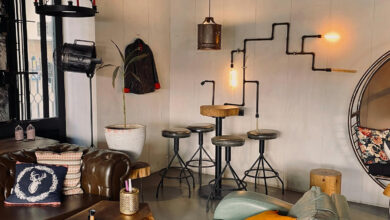Create a Cozy Atmosphere with Warm-Toned Floor Lamps

Want to create a warm, cozy atmosphere in your home? Need a simple, easy way to do it that won’t break the bank? Read on!
You don’t need to invest in expensive new furniture, re-carpet the whole place or paint everything. It’s as simple as turning on a light. The right light.
Warm-toned floor lamps have magical properties that can turn any room from blah to inviting in a snap. From the bedroom to the living room, here’s how to use them to their fullest potential.
Here’s what I cover in this post:
- Why Warm-Toned Lighting Makes All The Difference
- Choosing The Right Floor Lamp For Your Space
- Best Placement Strategies For Maximum Impact
- Pairing Floor Lamps With Your Existing Decor
Why Warm-Toned Lighting Makes All The Difference
Lighting is often an overlooked element in home decor. Most people focus on paint colors, furniture, and artwork. But lighting is what pulls everything together. It’s the difference between an empty room that’s easy to walk through and a warm space that invites you to curl up with a cup of tea and stay awhile.
Warm light in particular has this cozying effect. Cold fluorescent light makes a space feel sterile and uninviting, like a hospital or office building. Warm-toned lighting on the other hand softens everything. It soothes, relaxes and creates that all-important feeling of comfort.
That’s why people are turning to floor lamps in droves. The market for floor lamps is valued at $980 million in 2025 and growing rapidly as homeowners finally cotton onto the magic of the right light bulb.
Here’s the thing…
Not all floor lamps are equal. You need to know what you’re looking for to make your room feel like a cozy oasis.
Warm-toned bulbs are the key to achieving the cozy atmosphere you’re looking for. Check out labels when shopping for floor lamps and pick those that emit a soft, warm glow. Look for bulbs rated at 2700K to 3000K on the color temperature scale. Bulbs in this range produce a yellow or golden light that’s easy on the eyes and makes spaces feel more intimate.
Cooler bulbs rated at 4000K and above may be fine for task lighting in workspaces, but won’t do the trick for your living room or bedroom.
Choosing The Right Floor Lamp For Your Space
Floor lamps aren’t just lamps. They’re part of your overall decor and design aesthetic. Choosing the right lamp isn’t just a matter of picking one you like.
You’ll need to consider the size of the space and how it works with the furniture and decor you already have.
Here’s a quick quiz to help you figure out which floor lamp is right for you:
- What’s the purpose of this lamp? Are you looking for general lighting to brighten a dark area? Do you need a reading light next to your favorite chair? Or maybe you want accent lighting to highlight an artwork or painting.
Different purposes call for different floor lamp styles. Arc floor lamps work well for overhead lighting when you don’t have ceiling fixtures. Torchiere lamps use a reflective head that bounces light off the ceiling to create soft, diffused ambient lighting throughout the room.
Task lamps with adjustable arms are perfect for next to reading chairs or desks where you need focused lighting for work. Ambient floor lamps with fabric shades provide that all-important warm glow that makes a space feel cozy.
Size matters, too.
Tiny lamps are lost in large living rooms. Oversized arc lamps overwhelm a small bedroom. You’ll want to match the scale of the lamp to your space. Floor lamps should stand 58 to 64 inches tall on average.
Best Placement Strategies For Maximum Impact
It’s not enough to simply put a lamp somewhere and hope for the best. Lamp placement matters if you want to maximize their impact in your space.
Here’s a pro tip…
Coziest lighting is layered lighting. Interior designers love layered lighting that mixes ambient, task and accent lighting to create a warm, enveloping glow that makes your entire space feel more welcoming.
Layered lighting uses multiple light sources at varying heights and areas throughout the room. Floor lamps are essential because they add lighting at eye level where it has the most psychological impact on how we perceive a space.
Try starting with floor lamps in the corners of the room. Dark corners make a room feel smaller and more closed-in. A warm-toned floor lamp right there instantly brightens the area and makes the whole space feel larger and more open.
Next to seating areas also works well. Place a floor lamp at the end of a sofa or beside your favorite reading chair to create intimate pools of light that make those areas more inviting and cozy.
Just don’t do these things…
Don’t position floor lamps directly behind where you’ll be sitting. This causes backlighting and creates harsh shadows. Move lamps to the side for even illumination.
Pay attention to foot traffic patterns so people can move around easily without tripping over cords or bumping into lamps. Make sure there’s enough clearance on all sides.
Don’t position lamps too close to windows. During the day natural light will wash out the glow and make the lamps less effective.
Pairing Floor Lamps With Your Existing Decor
Floor lamps shouldn’t clash with your existing decor. They should complement and enhance it.
Luckily…
Warm-toned floor lamps go with pretty much any decor scheme. Whether you’re a modern minimalist or a country farmhouse girl, the right floor lamp can boost your existing decor while giving you that cozy atmosphere.
Floor lamps for modern spaces often feature simple, clean lines and geometric silhouettes. Metal finishes in brass, copper or bronze add warmth while still feeling sleek and contemporary. Tripod bases and arc floor lamps are especially popular.
Traditional homes benefit from lamps with classic shapes and details. Turned wood bases, fabric drum shades, and architectural design elements that harken back to classic design.
One style that’s gaining steam right now…
Natural materials. Bamboo, rattan, ceramic and wood bases create an organic warmth that fits with just about any decor. These materials pair perfectly with warm-toned bulbs to create multiple layers of visual and ambient warmth.
Pay attention to the lampshade as well. Fabric shades in linen, cotton or burlap diffuse light beautifully and add texture to the lamp itself. Fabric weave also affects the quality of light that comes through.
Skip lampshades in stark white or icy blue. These are cool colors that fight with warm tones in your lamp. Stick to cream, beige, warm gray, or even muted warm colors like terracotta, peach or pale gold for the lampshade.
Mix your metals and finishes thoughtfully, too. While a floor lamp doesn’t need to match your other brass and bronze finishes perfectly, it should still harmonize with your existing decor. Group lamps with warm colors together and cool ones together. Brass, copper, bronze and gold all mix beautifully.
Wrapping Up The Essentials
Warm-toned floor lamps are one of the easiest ways to create a cozy, warm atmosphere in your home. You don’t have to spend big bucks or rip out your walls.
Instead, add floor lamps in a few key areas to make the entire space more inviting. Remember to place them in corners and beside seating to maximize their impact. Choose floor lamps that complement the existing decor.
Don’t rely on a single ceiling light to light your entire space. Layer multiple warm-toned floor lamps throughout to create that cozy, inviting space where people want to sit and stay awhile.
The market for floor lamps keeps growing because more homeowners are catching on to what interior designers have known for years – lighting isn’t just functional, it’s transformational.
Pick a lamp, put it in the right place, and use a warm bulb. It’s as simple as that.




